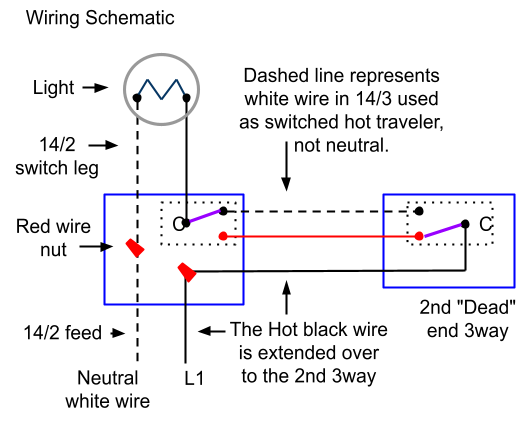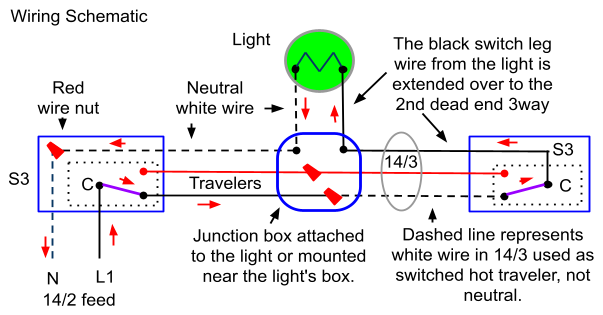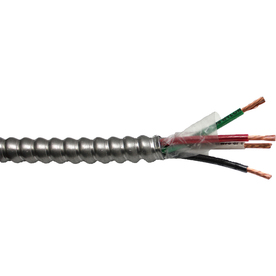Note, the following"Dead end" methods will have one of the 3 way switches missing a neutral which is now required at all switch locations. A 4 conductor (14/4 with ground or 12/4 wg) can be used instead of the 3 conductor (14/3wg) to meet this code.
S3 Method #2 Dead End 3way With Extended Switch Leg
Rating Above Average B ☺ Commonly used by professional electricians.
Level Intermediate
Description Power and switch leg at one end, dead end of a 3 wire at the other.
The line diagram looks the same as a Basic 3way...

► Compare the Wiring Schematic above with the photo below. #1 and #6 are the common terminals , L1 is the incoming hot feed;
A "Dead End 3 way" switch wiring method. This method is commonly used by professional electricians. There are 2 variations of Dead End 3ways; extending the switch leg over to the common as shown in the photo above, or extending the hot over to the common as described below. You can copy this photo and any part of this site for classroom or individual use.
S3 Method #2.2 Dead End 3way with Travelers at Light
Rating Below average D - ☹
A 2 wire switch leg is the only connection that should be at the light yet this method requires cutting and reconnecting the travelers at the light. Notice the 2 red wire nuts on the travelers in the wiring schematic below and compare that with no wire nuts on travelers in the methods above. The extra connections in this method mean you have to; get a ladder, go up the ladder, raise your hands to the ceiling, strip, twist together, connect and cap the traveler wires. All of this is unnecessary in the previous methods.
► Compare the Wiring Schematic above with the photo below. #1 and #6 are the common terminals , L1 is the incoming hot feed;
 |
| Wiring diagrams and photo by Jim Morelli. You may copy for classroom instruction or personal use. |
Rating Above Average B ☺ Commonly used by professional electricians
Level Intermediate
Description Power and switch leg at one end, dead end of a 3 wire at the other.
Again, the same line diagram...

..but different use of L1 and the switch leg from the light. The only change in wiring has to do with which common terminal will receive the hot wire and which common will receive the switch leg wire. In this method the hot is extended over to the dead end 3way's common instead of the switch leg.

If the diagram is having trouble loading, here is another view
We just learned 2 different methods of wiring a dead end 3way. Many electricians are unaware that there are 2 dead end methods. They think there is only one method, the one that they learned either extending the hot or extending the switch leg. Troubleshooting a bad light will be easier if you are aware that the common on the dead end 3way can be either;
➪ hot all the time (extended hot) OR
➪ a switched hot (extended switch leg).
If the diagram is having trouble loading, here is another view
We just learned 2 different methods of wiring a dead end 3way. Many electricians are unaware that there are 2 dead end methods. They think there is only one method, the one that they learned either extending the hot or extending the switch leg. Troubleshooting a bad light will be easier if you are aware that the common on the dead end 3way can be either;
➪ hot all the time (extended hot) OR
➪ a switched hot (extended switch leg).
Look at both "dead end" methods again in this side by side comparison.
Notice the different roles of the solid black wire in between the switches.
Method #2 extends the black switch leg from the light.
Method #2.1 extends the black hot L1.
Notice the different roles of the solid black wire in between the switches.
Method #2 extends the black switch leg from the light.
Method #2.1 extends the black hot L1.
| ----------Method 1------------ |
| ------------ Method 2 ----------- |
S3 Method #2.2 Dead End 3way with Travelers at Light
Rating Below average D - ☹
A 2 wire switch leg is the only connection that should be at the light yet this method requires cutting and reconnecting the travelers at the light. Notice the 2 red wire nuts on the travelers in the wiring schematic below and compare that with no wire nuts on travelers in the methods above. The extra connections in this method mean you have to; get a ladder, go up the ladder, raise your hands to the ceiling, strip, twist together, connect and cap the traveler wires. All of this is unnecessary in the previous methods.
Level Advanced
Description Power at one end, 3 wire run from first S3 to light and another 3 wire run from the light to the dead end S3 (at the right in the wiring schematic). All wires junction at the light box. Except for a change in wire color on one traveler, the line diagram looks the same as the previous method but the wiring schematic is totally different.


S3 Method #3 Radical 3way
S3 Method #3 Radical 3way
Rating Poor F - ☹ Not typical, not recommended.
A 4way cannot be added to this method. Only traveler wires should be on traveler terminals, yet this method has a traveler and a hot on the same terminal and, on another traveler terminal, both a traveler and the switch leg. Bad idea but shown here to help you recognize it if you ever have to work on it.
A 4way cannot be added to this method. Only traveler wires should be on traveler terminals, yet this method has a traveler and a hot on the same terminal and, on another traveler terminal, both a traveler and the switch leg. Bad idea but shown here to help you recognize it if you ever have to work on it.
Level Advanced
Also called a "California 3 way"
Also called a "California 3 way"
Description Power and switch leg at one end, dead end of a 3 wire at the other. The hot and switch leg are extended over to the traveler terminals on the dead end 3way. The common terminals of each S3 are connected together and to nothing else. 2 traveler terminals, one from each S3, are connected together and connected to the hot. The 2nd set of traveler terminals are connected together and connected to the switch leg of the light. Power and switch leg have to be at one end for this method otherwise a 4th wire would be needed for the neutral.
Experienced electricians, unaware of the Radical method would have a hard time troubleshooting this mess. Normally, in all other methods, only one traveler wire is energized while the light is on but here all 3 wires are energized as shown in the "Line Diagram Light On " above.
Another major problem with the Radical method is that a 4 way switch cannot be added into the travelers. The 2 diagrams below shows a 4 way added into the traveler wires and yet the light stays on even after the 4 way switch is flipped.



Hi, This is Mark (markofinney@gmail.com) Wow! Thanks Dean, This is a very clear presentation of the circuit. We are leaving for dinner now so I will take a closer look later. Thank you for the great learning opportunity. I will let you know where and when the box is found. It's similar to the Winter Carnival medallion hunt......well maybe not.
ReplyDeleteI can't thank you enough for helping me fix the mess I had between two 3-way switches on my staircase. Turns out it was #3, the Radical 3Way, with a few more items added on for confusion. An electrician spent about 6 hours with it and couldn't get it to work right. After spending some time mapping out what I had, I eventually figured out that #3 might be the solution, and it worked. Thanks!!!
ReplyDeleteGood for you!
DeleteYes the "Radical" 3 way method is a crazy one. The first time I saw it I couldn't believe it works. It is a method that nobody should use on a new project and one that I posted only for the purpose of helping someone like you.
Glad I could help.
I have never, ever seen this method to wire 3 way switches before; and hope I never see it in the field. Calling it a "California 3 Way" seems to make sense!
ReplyDeleteNeed a Residential or Commercial electrician near you? We at Akron Electricians has a team of licensed Electrical Contractor serving the entire Columbus, Ohio area. Your local and affordable electrician. For any electric repair need Call 330-752-8419.
ReplyDeleteCalifornia 3 way is just plain dumb. It could easily just be respliced to work the right way as shown in the previous dead end methods. I would smackafool if I ever caught someone doing something that stupid.
ReplyDeleteHi, I'm having a bit of an argument as my boss wants me to use the white wire to carry power or the SL over for a dead end three-way. I've always been told to use the black wire! Is there any rule against doing this?
ReplyDeleteThanks
Matt
Only if you read the code book.
Delete200.7 (C) (1)
ReplyDelete